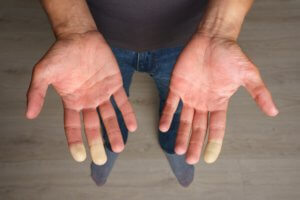08 Jan The Cold Truth Behind Raynaud’s Phenomenon
When the winter wind howls and the mercury drops, some people don’t just experience the typical chill – their fingers and toes put on a dramatic display of color changes from white to blue and then red. This peculiar and often painful condition is known as Raynaud’s Phenomenon, a tale written in the capillaries of the extremities. But what exactly is happening beneath the skin? Let’s unwrap the mystery.
What Is Raynaud’s Phenomenon?
Raynaud’s phenomenon is a vascular disorder where the small blood vessels in the extremities overreact to cold temperatures. This reaction causes a temporary restriction of blood flow, leading to characteristic color changes. For some, Raynaud’s is a standalone condition known as “Primary“. For others, it’s associated with more complex systemic diseases, which is then termed “Secondary”.
Symptoms of Raynaud’s
The symptoms of Raynaud’s are as clear as they are colorful. Initially, the fingers or toes turn white as the blood flow diminishes, followed by a bluish hue as the oxygen levels drop. As the area begins to warm up and the blood flow returns, a red flush can appear, often accompanied by tingling, swelling, or a painful throbbing sensation.
 Who Is at Risk?
Who Is at Risk?
Raynaud’s is relatively common, affecting about 3–5% of the population. That said, it tends to favor certain demographics. For example, it is more common in colder climates and affects more women than men. It often first appears between the ages of 15 and 30.
Understanding the Triggers
Though the cause of Primary Raynaud’s is unknown, certain conditions aside from the cold can exacerbate the condition:
- Emotional stress
- Smoking
- Medications
- Injury or trauma
- Prolonged use of vibrating tools
Managing Symptoms
Living with this phenomenon means getting creative with warmth. Layering up, packing heat pads, and steering clear of stress are part of the daily forecast. For many, these lifestyle adjustments are enough to keep the symptoms in check. However, when the condition turns severe, medical intervention may be necessary.
Conclusion
Raynaud’s Phenomenon may not be as well-known as the common cold, but for those affected, it’s a wintertime narrative that can’t be ignored. By understanding the condition and embracing proactive measures, those with this condition can write their own story of comfort and resilience against the cold.

